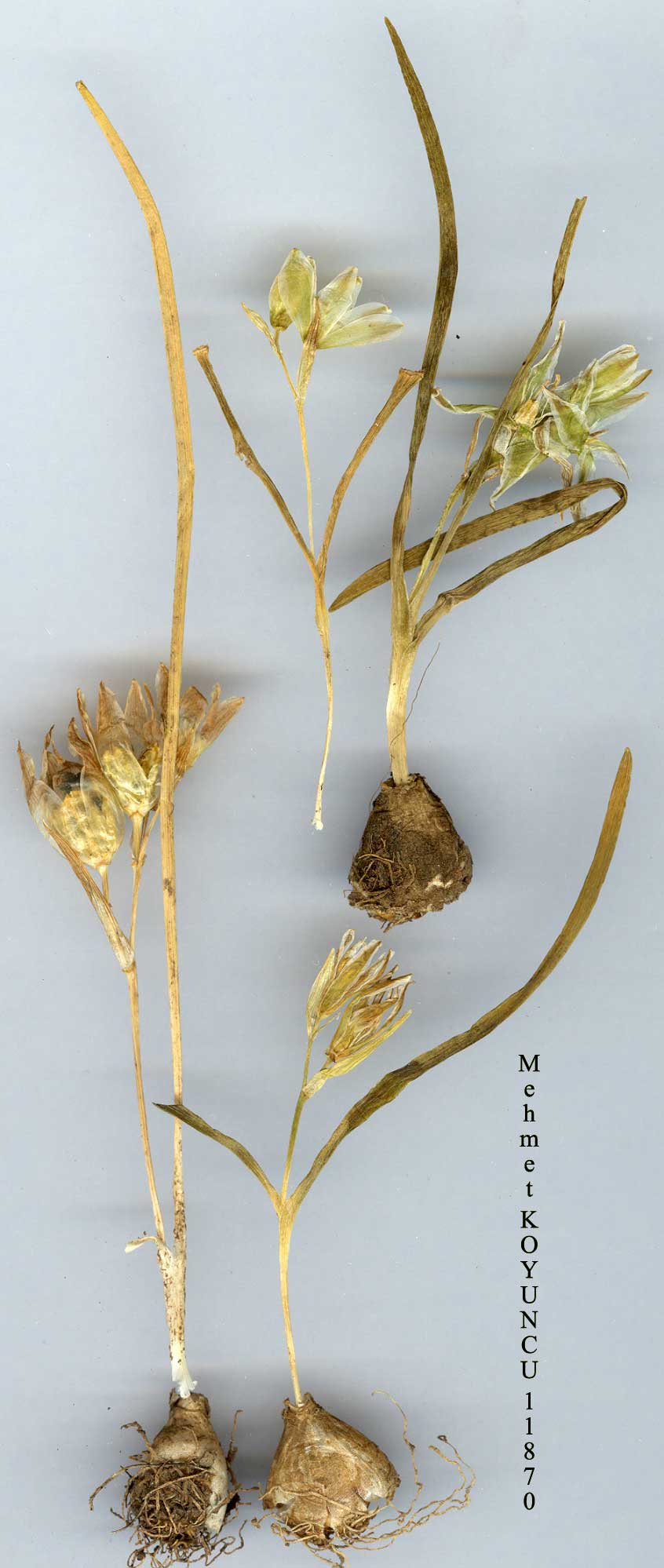| Liliaceae |
|---|
Ornithogalum L. |
O. oligophyllum E.D. Clarke, Travels 2(3):555 (1816). Syn: O. aucheri Boiss., Diagn. ser. 1(5):65 (1844)! O. bifolium C. Koch in Linnaea 19:10 (1846); O. aemulum Schott & Kotschy in Öst. Bot. Wochenbl. 4:162 (1854); O. brevipedicellatum Boiss. ex Baker in J. linn. Soc. (Bot.) 13:263 (1873)! O. balansae Boiss., Fl. Or. 5:222 (1882)! Ic: Grey-Wilson & Mathew, Bulbs t. 15(1981). Figure 11. Scape erect, 4-15 cm. Leaves 2-3 (rarely more), often glaucous, narrow at base, broadening appreciably upwards and the abruptly tapering to rounded or subacute apex, narrowly spathulate, longer or shorter than scape, without a white line on upper surface; margins entire, glabrous. Raceme with 2-5 or rarely more flowers, at first very condensed, pedicels shorter than to as long as flowers at anthesis. Perianth segments 11-16 mm, white inside, white with a green fascia outside. Fruiting pedicels erect-spreading, 10-30 mm (longer in shaded specimens). Capsule winged. 2n=20, 24. Fl. 4-7. Grassy and rocky slopes, snow patches, 700-3000 m. Type: [Turkey/Bulgaria] in the route between Constantinople (Istanbul) and Rustchuk (Ruse, Bulgaria), E.D. Clarke (holo. BM). Mainly N., S. & Inner Anatolia. Lycia, in regione alpina, Bourgeau 1860: 264 (type of O. brevipedicellatum)! A2(A) Bursa: Ulu Da., 1600 m, Moore 7265 (2n = 20)! A3 Bolu: Abant G., Heilbronn & Başarman! A4 Bolu: 34 km S.E. of Gerede, 1600 m, Sorger 62-82-32! A5 Samsun: Ladik, 1200 m, Tobey 573! A6Sivas: 30kmN.E.of Zara towards Suşehri, 1530 m, Kukkonen 5427! A7 Trabzon: Zigana pass to Istavriköy, 2350 m, A. & T. Baytop (lSTE 15352)! A8 Rize: Ikizdere to lspir, 3000 m, Stn. & Hend. 6239! A9 Kars: Yalnizçam Da. between Yalnizçam and Ardanuç, 2250 m, D. 29668! B2 Kütahya: Murat Da. above Banaz, 2150 m, Coode & Jones 2513! B3 Konya: Beyşehir to Akseki, 1500 m, Demiriz 4508! B5 Kayseri: Bakir Da. at Akoluk Y. above Kisge, 2000 m, D. 19440! B6 Sivas: Bey Da. S. of Zara, 2000 m, Stn. & Hend. 5319 (2n = 24)! B7 Sivas: Kizildağ, 2150 m, Lamond 2630! B8 Erzurum: pass between Erzurum and Çat, 1800 m, Rix 1684! B9 Bitlis: Karz Da. above Kotum, 2225 m, D. 22290! B10 Kars: N.E. slope of Ağri Da., at Serdar Bulak, 2500 m, D. 43763! C2 Denizli: Honaz Da., 1650 m, Tuzlaci (lSTE 27994)! C3 lsparta: Dedegöl Da., 1400 m, Sorger 64-42-21! C5 lçel: 15 km S.W, of Pozanti, 1600 m, lt. Leyd. 1959:1290! C6 Hatay: d. Belen, Karlik Tepe, above Soğuk Oluk, 1200 m, D. 2706îa! C7 Urfa: Karaca Da., 2100 m, E.S. Brown 2509! C10 Hakkari: 10 km N. of Yüksekova, 1930 m, Trelawny & McPhail 2023! Balkans, Georgia. Some specimens are difficult to distinguish from O. wiedemannii and may be intermediate (e.g. A4 Zonguldak: Kel Tepe, 1550m, Tobey 1850! B9 Van: N. side of Erek Da. above Değirmenköy, 2500 m, D. 44481!). A specimen from A5 Amasya: Taşli Y., Ladik, 1600 m,Tobey 573a!is very robust with large racemes; it nonetheless appears to be O. oligophylium. The label states 'heavily fertilised by sheep.' O. schmalhausenii Albov is recorded for Turkey by Grossheim (Fl. Kavk. 2: map 193, 1940). The type (photo E!) is poor, but it appears to be O. oligophylium. Other material I have seen determined as O. schmalhausenii is O. sigmoideum. Material from the S.W. part of the range of the species ('Lycià, Antalya, lsparta, Konya) has a somewhat different facies from the rest, though it has not been possible to find workable characters to separate it; if separable it will have to be named O. brevipedicellatum Boiss. |








